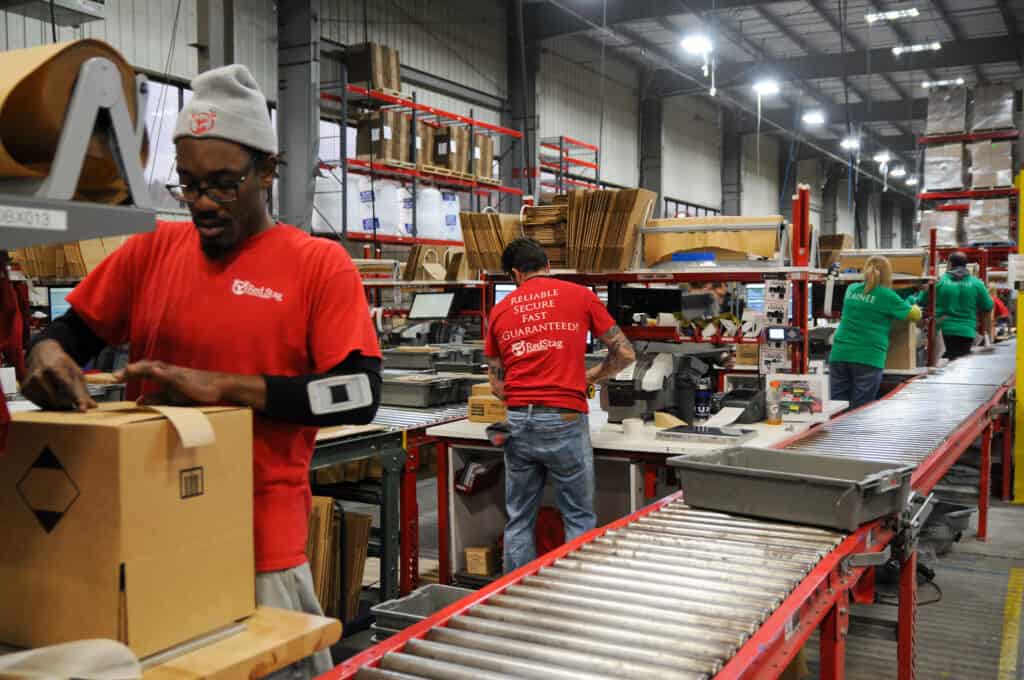In recent years, the explosive growth of eCommerce has led to many new, supporting businesses in the logistics space. One type of operation helps sellers by storing, packing, and shipping sold goods, and such a pack and ship store business plan can quickly turn into a very lucrative affair. At its heart, that’s how every strong 3PL like Red Stag Fulfillment starts.
With the growing number of eCommerce businesses in the U.S., it may be a smart move for you to start your own operation. So, let’s look at what’s needed in a pack and ship store business plan. It may shed some light on if this is the right business for you.

Defining a pack and ship store business plan
If you think a pack and ship operation is suitable for you, then it’s time to plan. You’ll need to carve out your niche, find a location, and create documents that help you hire executives, secure bank loans, or get other financial partners. The business plan is the right place to start, so let’s look at what that is.
Writing the pack and ship store business plan
Part of figuring out how to create a successful pack and ship store business plan is getting each of the necessary parts correct. Business plans look very different and should be tailored specifically to your operations. That said, most do have common elements that will help. Here are six must-haves for your pack and ship store business plan.

1. Executive summary
Think of this as your elevator pitch, or what you’d say if you made it in front of the sharks on Shark Tank. You want to introduce the other aspects of your business plan briefly, and you need to highlight what you think will make you successful. Don’t make it just a table of contents. Share your goals and dream, using the end of this section to introduce your audience (potential investors) to the data that backs up your projections.
For a pro-tip on these, write the executive summary last. You want it to truly summarize the rest of the document and only use metrics, statistics, and reasoning present in the other sections. Tackling it last can help you keep things consistent and get you in the writing spirit to make your best case.
2. Business description and structure
Here’s perhaps the most exciting and essential part of your pack and ship store business plan. This section is where you explain what your business does and how it’ll operate. Describe the processes you’ll follow, the size you expect to be, and the business’s legal structure. Having relationships with national and regional carriers is essential here. Use this section to discuss your arrangements and if you’ve negotiated any deals with carriers.
Business structure is crucial, and the need has elements specific to pack and ship stores. That’s because you’ve generally got a few options for forming your business. You might start your own business from scratch or purchase an existing operation from another owner. However, you may also franchise an opportunity and become the owner and manager of a FedEx- or UPS-branded store location.
You’ll also need to decide if you want to help regular consumers and shoppers. These people will come in at any time with a package, and you’ll work to get it shipped. Or, you could be a 3PL and offer fulfillment services to businesses like us at Red Stag Fulfillment. This dramatically shapes how your business operates each day.
The structure is important because it helps you get realistic about startup expenses. Franchise options come with initial franchise fees, but you may get support with acquiring the land needed or market research from the main company. Buying a store or existing franchise location can easily cost hundreds of thousands of dollars, but the revenue potential may make that a minor concern.
3. Products and location
Pack and ship stores need three things to perform well: a relationship with a carrier, a location that’s easy for customers and carrier trucks to access, and quality packing materials that will minimize damage during transit. Use this section to specifically explain your thoughts on each.
We discussed carrier relationships above, and this is a place for you to define the pricing or advantages you’ve received during negotiations. For the location, explain how close you are to population centers, ease of access to highways or interstates, and how easy it would be for a carrier’s large truck to access your docks. Remember, you need to be usable by both customers and partners.
Finally, provide some information on your approach to packaging. You may not perform this function for many of your customers, but some will need it. That’s an excellent place for you to be a valuable partner. If you have a business idea for maximizing this or improving your margins, explain it here. Often, that’s with products designed to support standard shipments or for you to discuss how you can bake the cost of packaging products into the services you provide.
4. Market research
The market for 3PLs and consumer-facing pack and ship stores is significant. There’s plenty of room for new competitors to make a name for themselves. What you want to do is show how it makes financial sense for you to create a niche. Explain the overall market as well as your specific target. Tell potential investors how you’ll get there and why it will have significant returns.
In this section, include sales forecasts, milestones, timetables, marketing, and other strategies. You’ll always want to discuss your competition. For pack and ship store business plans, it’s good to know the physical locations of competitor stores so you can explain how your proposed location will address an underserved customer base.

5. People
A core part of any business plan is an explanation of who is on board already. Give information and bios of your company executives and management team. Explain their expertise in this field as well as in other entrepreneurial or franchise endeavors. Try to link each individual’s expertise on your team with a specific solution to a common industry problem. You want to position every person to address risk.
Pack and ship stores are labor-intensive operations. So, in this section, you may want to include an estimate of your total labor for sales and warehousing. Address salaries of these employees and leadership to verify that your current and projected financials will cover these costs.
6. Current financials
Before this section, most of the pack and ship store business plan will be about your goals and aspirations. They cover the start of the business and what you want it to become. Your financials section is where you back up that game plan with hard facts and figures. Provide the numbers, full estimates, and current financial status to let an investor or lender see that you’re a smart investment. Base as much as possible on current market trends and established values.
In general, you want to provide conservative figures and projections for your costs and potential revenues. Try to plan at least three years out, especially for cash flow and how you think you’ll reinvest earnings. Make your case and set a reliable path forward.

Starting your operations
Creating your pack and ship store business plan is just the first step. From there, you need to run operations and satisfy customers. That takes a lot of hard work but will be genuinely rewarding when you get it right. Our biggest piece of advice as you get started is to create a firm pricing strategy.
Fulfillment operations all run on relatively tight margins. You become a leader by being reliable (guarantees always help) and offering valuable add-on services. Instead of trying to reinvent the wheel, do your homework. Find out what small consumer-facing stores charge. Look at the deals you can negotiate with carriers. Interview warehouse providers to see what they charge for labor and other fees.
Seek out ways to save, whether that’s starting with a smaller crew or offering boutique solutions like just serving a regional area. Find out what will make you unique, like Red Stag’s capabilities serving companies that sell heavy, bulky, oversized, and luxury goods. We work with companies of all sizes and product types, but few 3PLs can match our expertise with those larger items.

Growing the community together
Red Stag Fulfillment works to tackle the storage, packing, and shipping of our customers’ products. When you reach out to us, we review your company, products, and orders. Then, we’ll help you find the best possible partner for your business. Our services and our referrals are designed to give you the fulfillment your business and products deserve.
It’s a great day to be in the fulfillment space, and we’re always excited when someone new joins.
Learn what questions business customers will ask you with our free eBook






